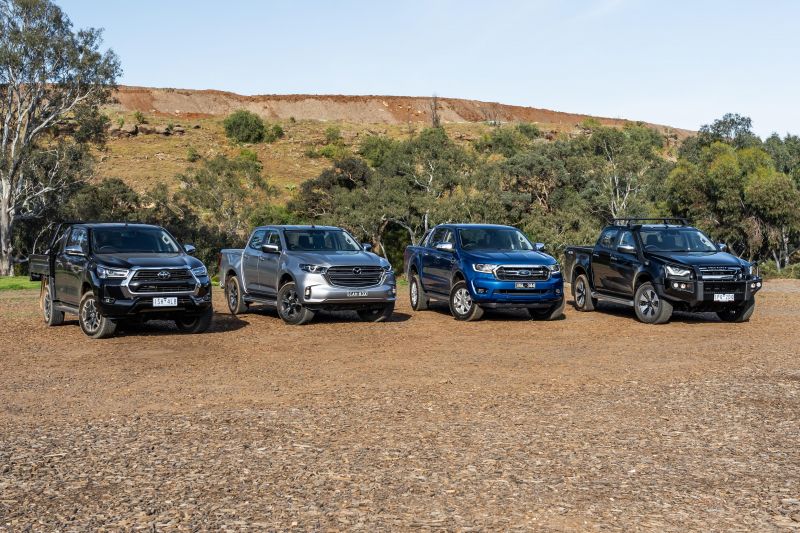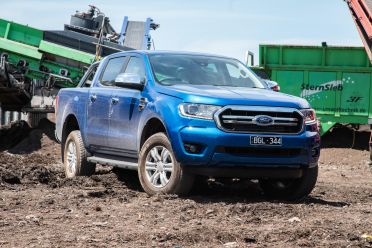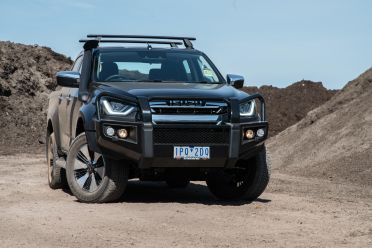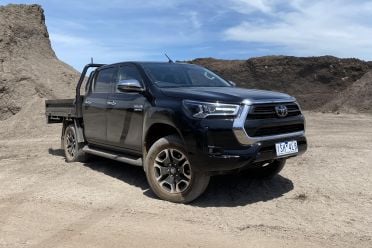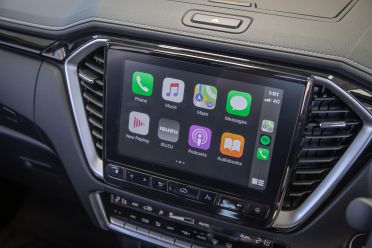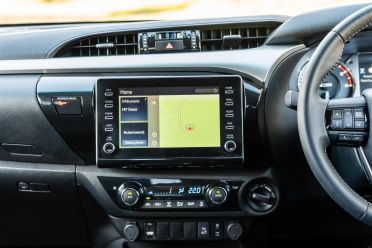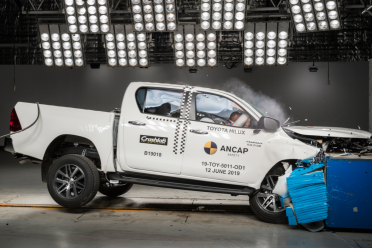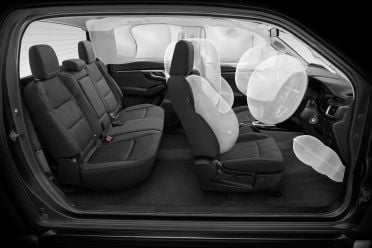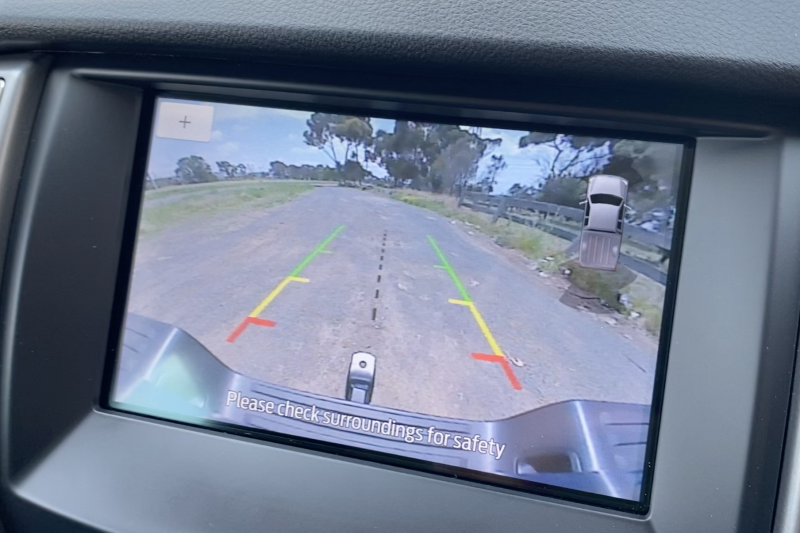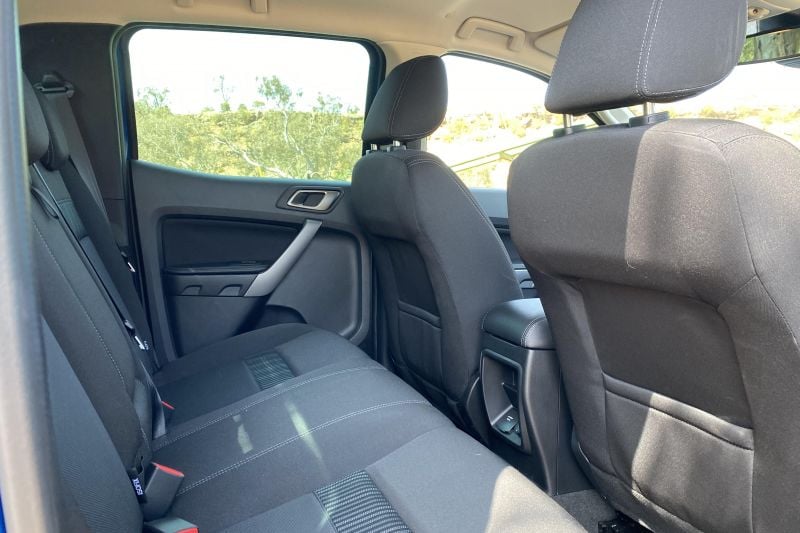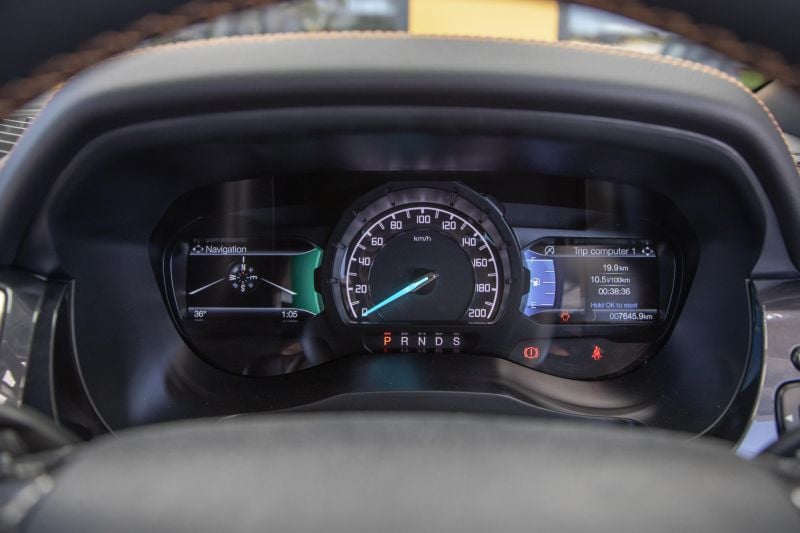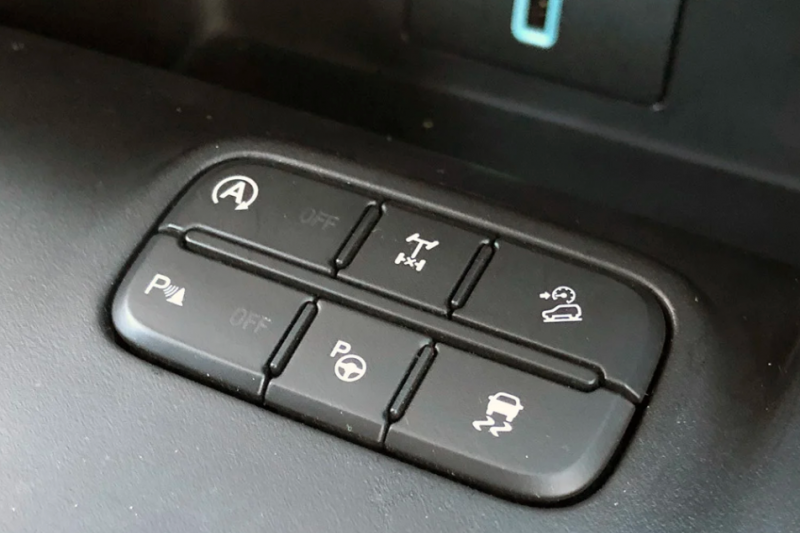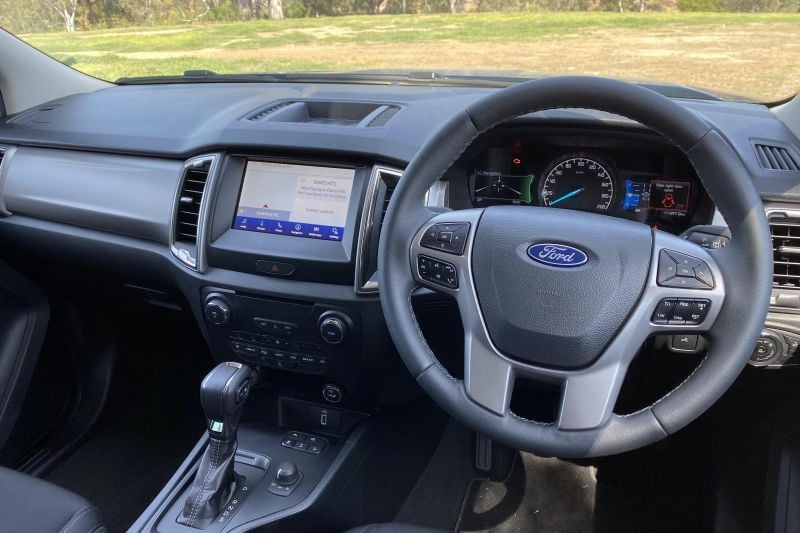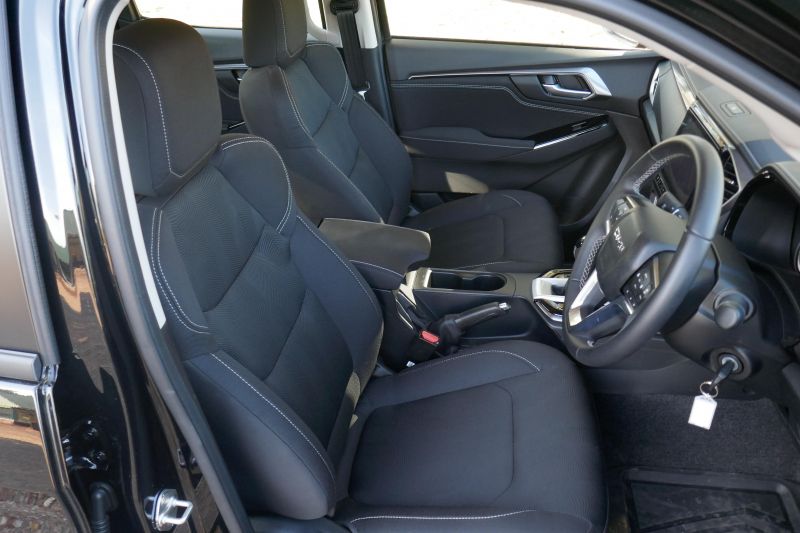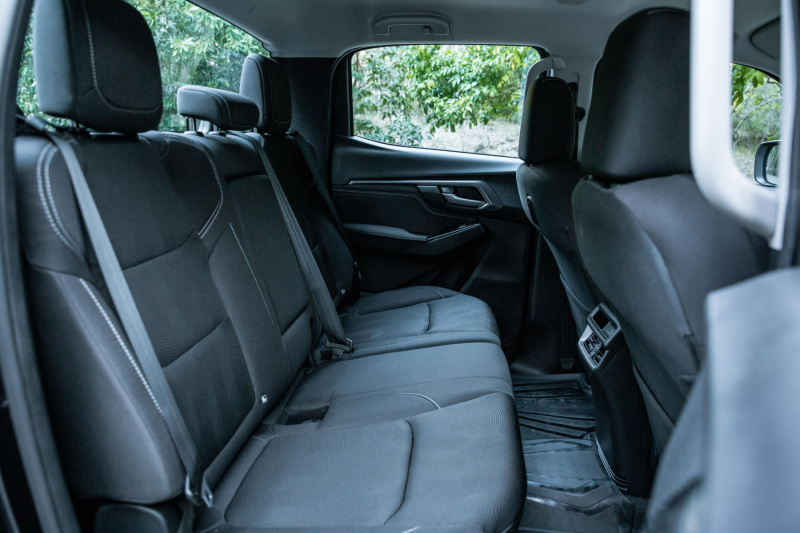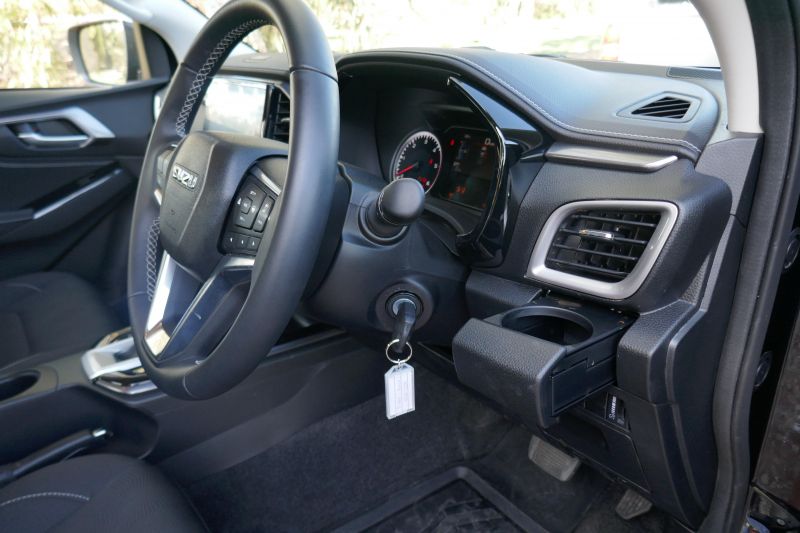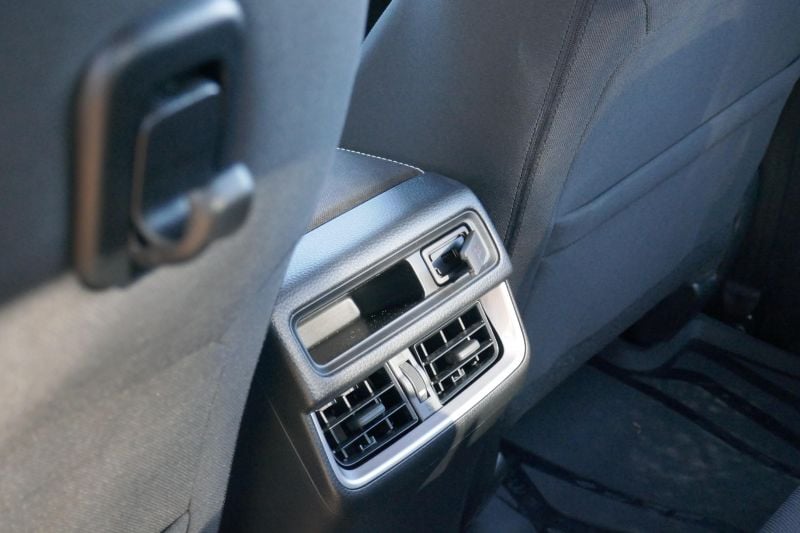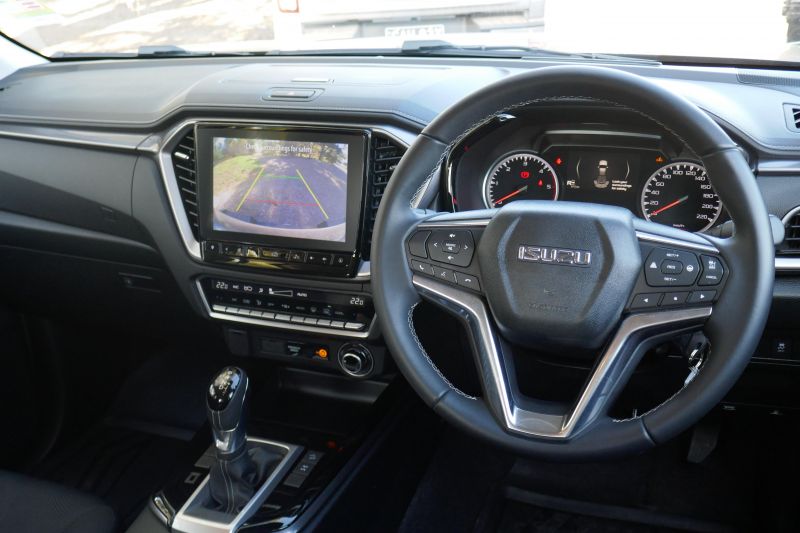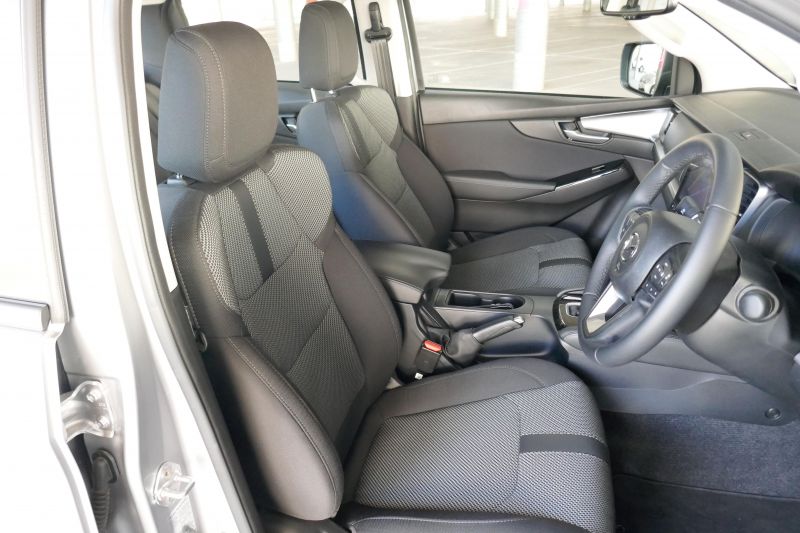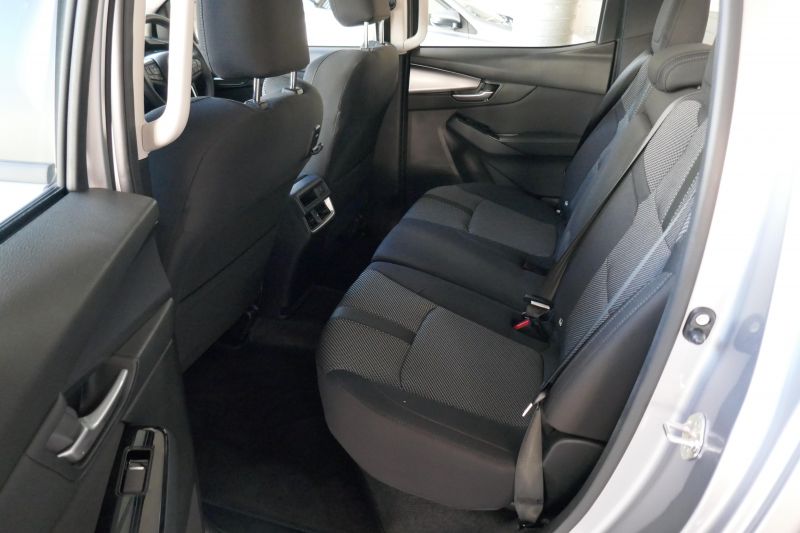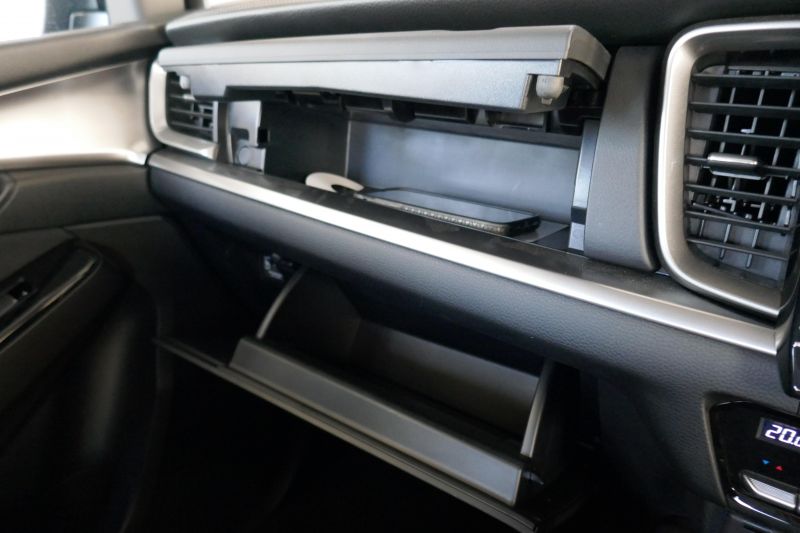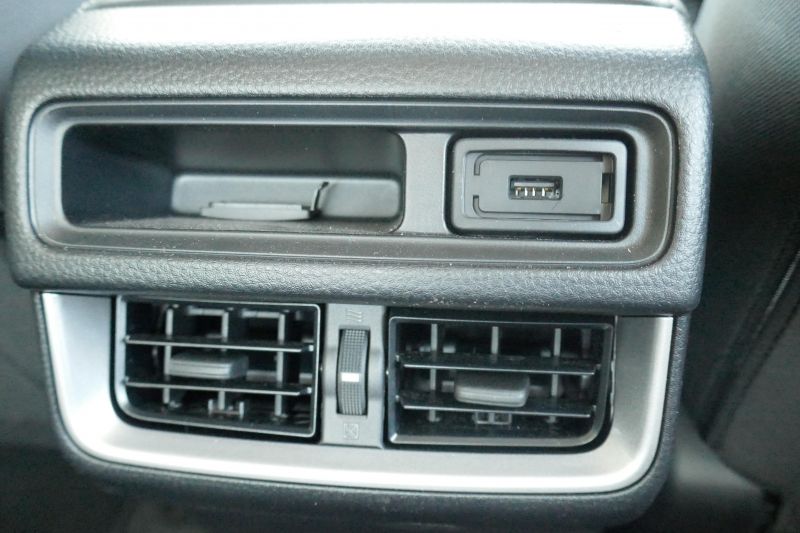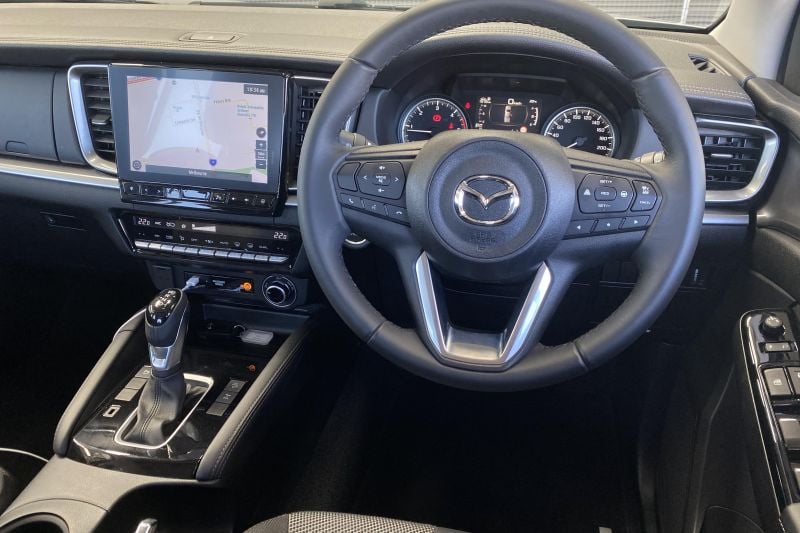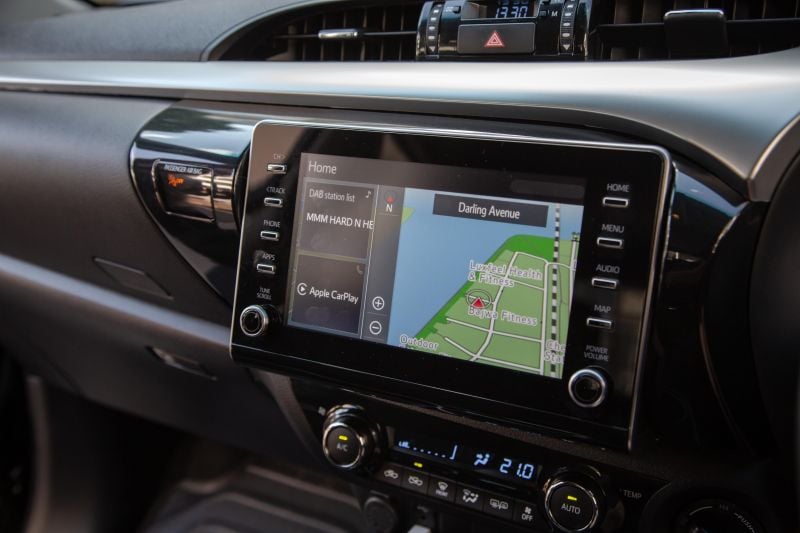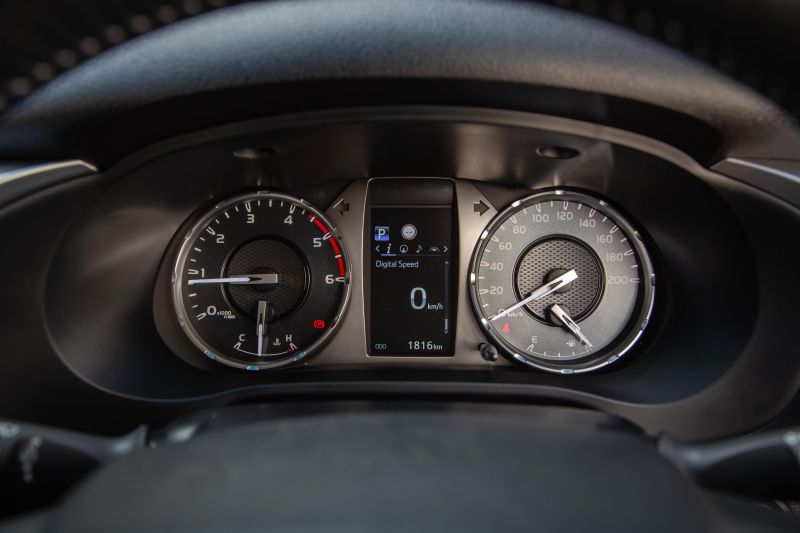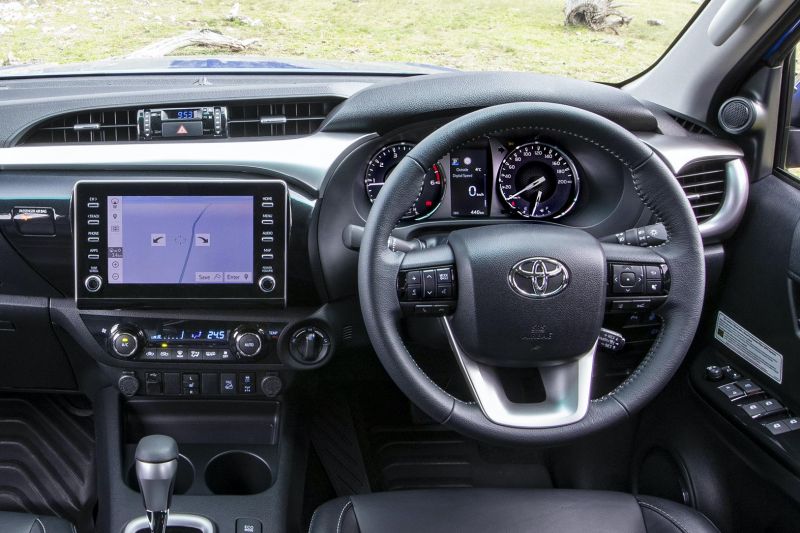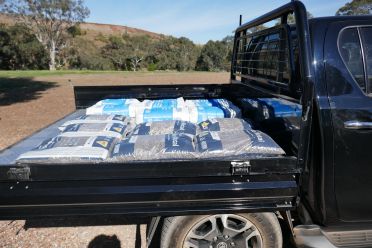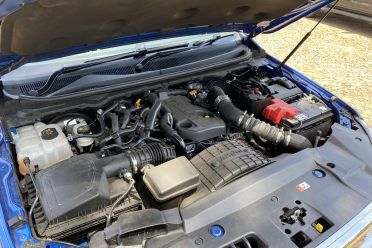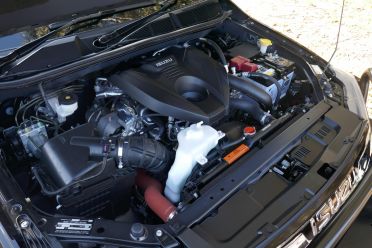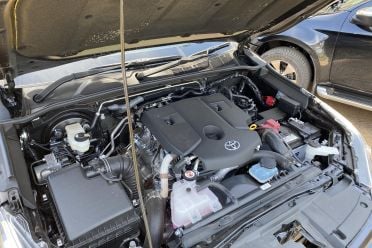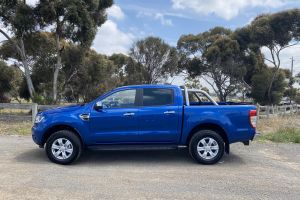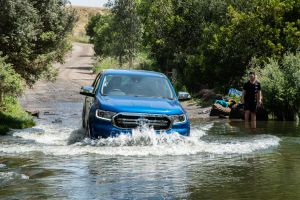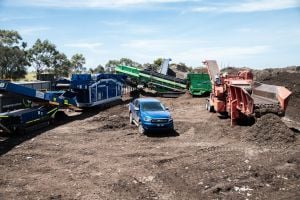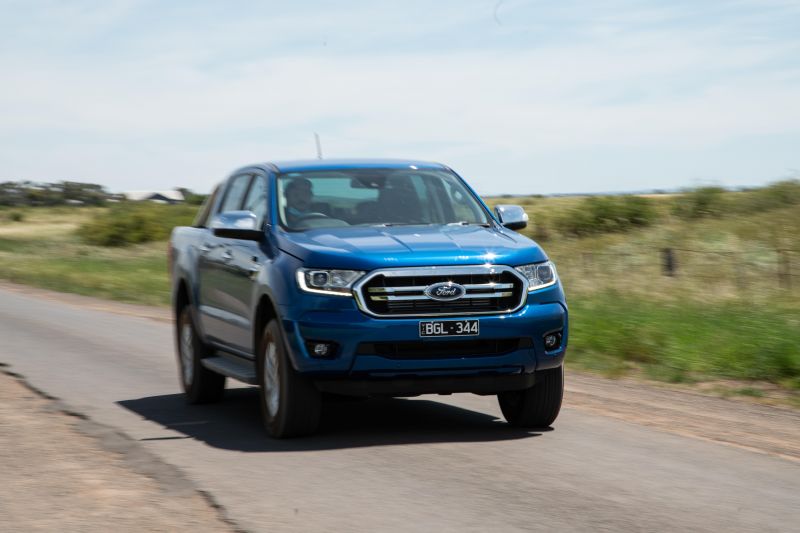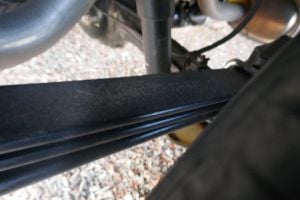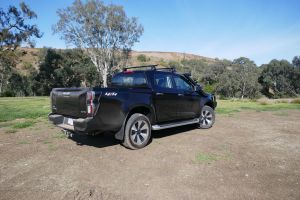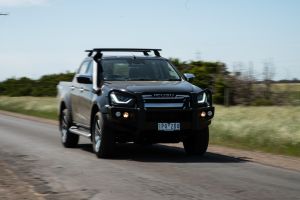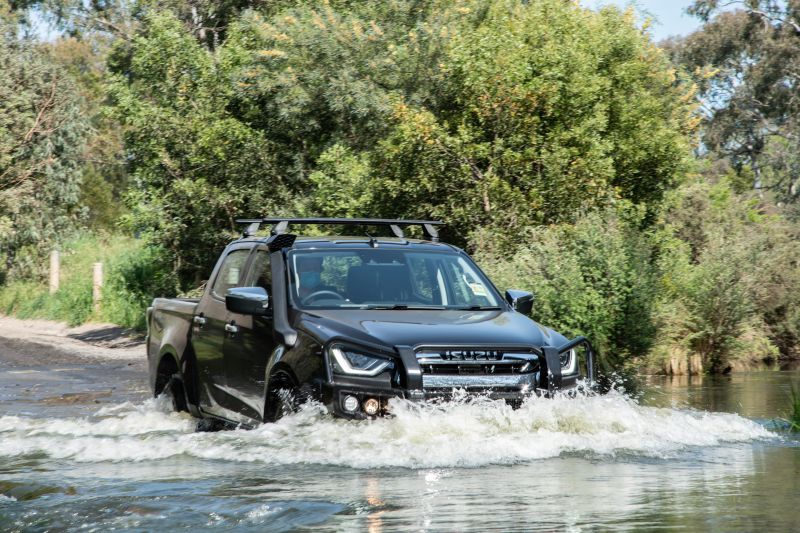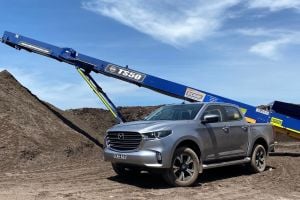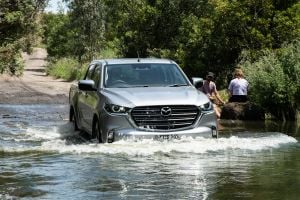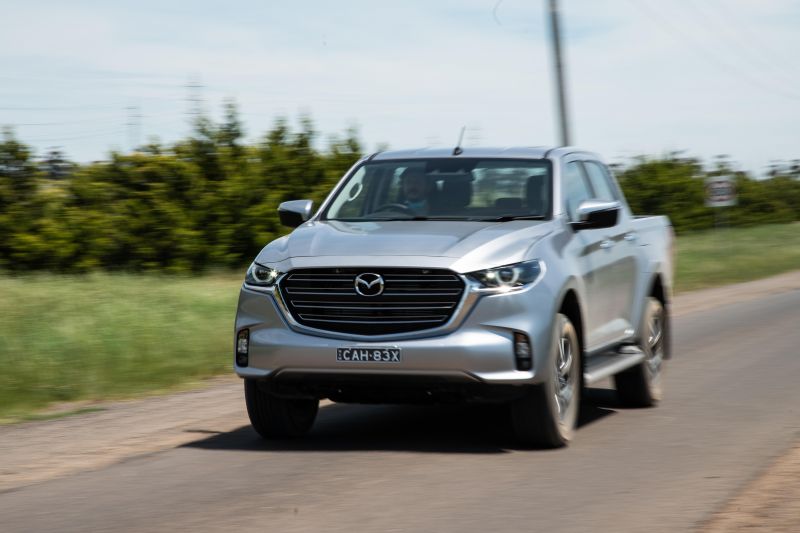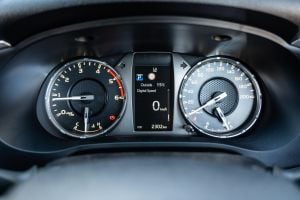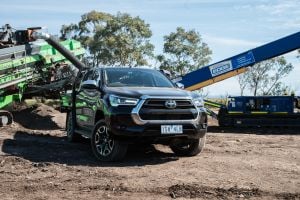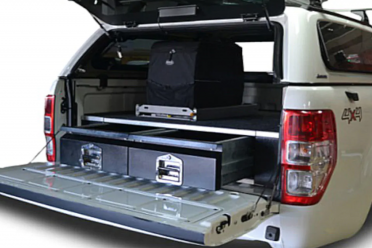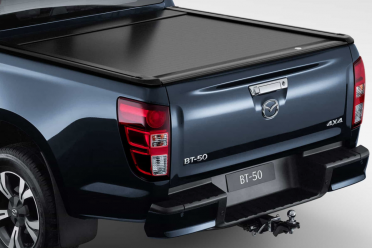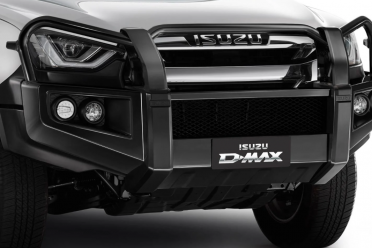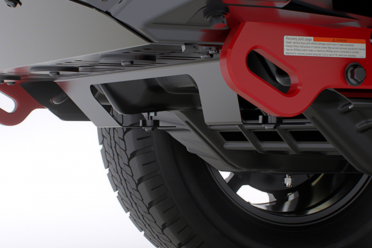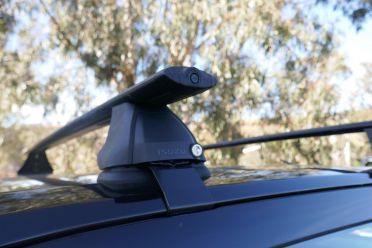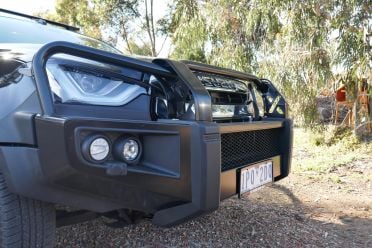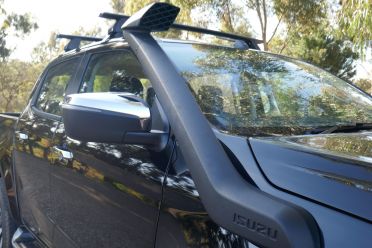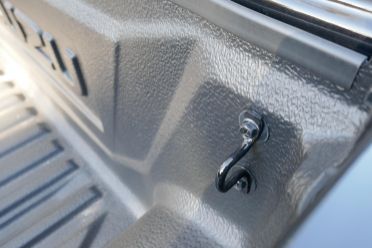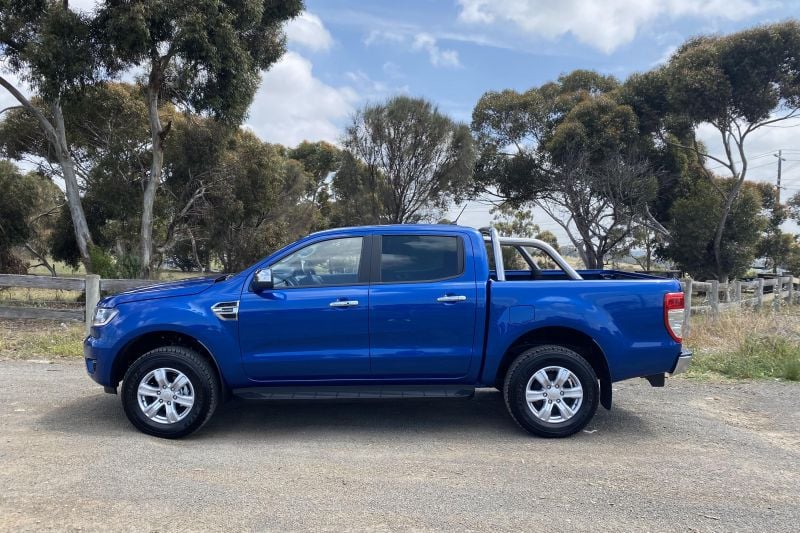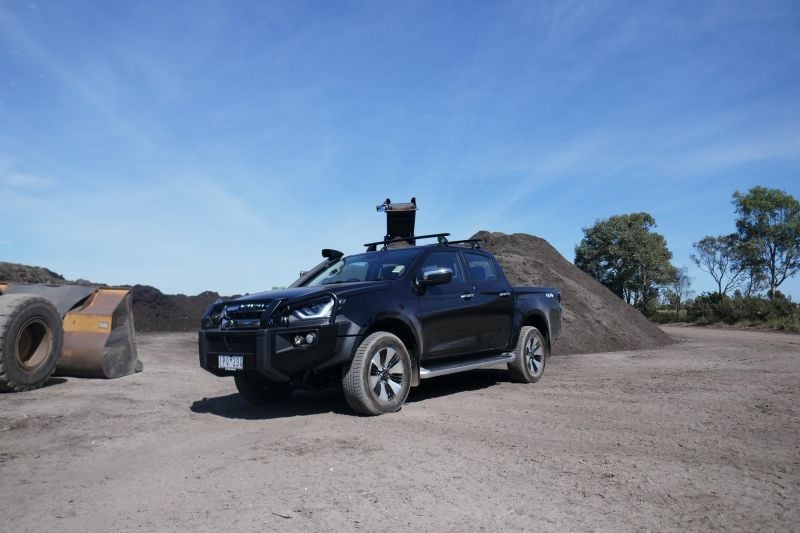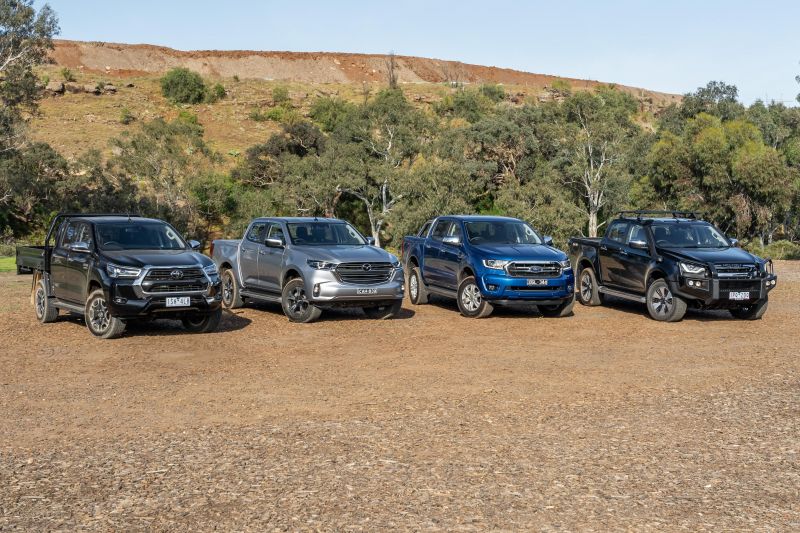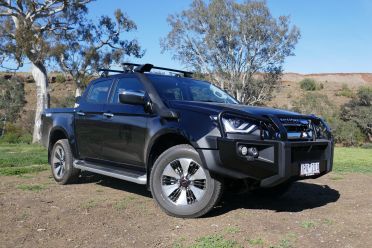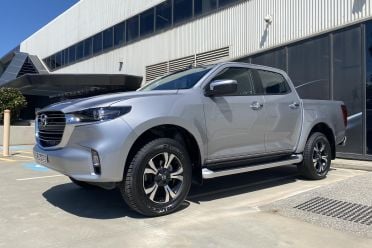About 20 per cent of all new vehicles purchased in Australia this year have been a ute/pickup truck, and it’s this enduring popularity that is driving such strong competition.
The Aussie-engineered Ford Ranger has become top-seller in the 4×4 segment, making it an obvious competitor. Moreover, constant running updates over its long life cycle have kept it sharper than you might expect.
Its closest competitor in the 4×4 sales race is the Toyota HiLux, which just received a significant mid-cycle upgrade with more power, rejigged suspension, a bolder front design, and slicker new touchscreen interface.
Rounding out this four-way battle are twins: the brand new Isuzu D-Max and the Mazda BT-50, both of which stack up as major step-changes over their respective predecessor models.
While the Nissan Navara, Mitsubishi Triton, Volkswagen Amarok, and even lower-profile offerings like the LDV T60 all have their place, it’s this big four that are – right now – the four best all-round contenders.
How much?
All four models on test are highly specified variants, positioned a rung or two below the top-of-the-range offers.
The Ford Ranger XLT wears a list price of $60,940 before on-road costs in ute form, or $59,940 in cab-chassis dual-cab guise. The Isuzu D-Max LS-U ute’s list price is $56,900, the Mazda BT-50 XTR ute is $57,210, and the Toyota HiLux SR5 is $59,920 in ute form or $58,420 as a cab-chassis.
As we often find with commercial vehicles though, the price you’ll pay in the real world is quite different. These list prices are all before stamp duty, dealer delivery and rego, and sometimes brands offer campaign drive-away pricing for private or ABN holders.
At the time of writing, the Ranger XLT was advertised on Ford’s own site at $56,490 on the road, provided you have an ABN. Likewise, Mazda has announced small fleet ABN pricing of $56,490 for the BT-50 XTR as tested.
Isuzu has no deals advertised for the D-Max LS-U, though the more expensive X-Terrain is advertised at $58,990 drive-away so it would be reasonable to expect the LS-U’s real-world pricing to be lower than this since it has less equipment. Toyota likewise has no factory deals advertised, and if you configure a drive-away price on its site the figure is about $64,000.
At the end of the day, a degree of discussion with your local dealer (preferably with your ABN in hand) is likely going to be required. Based on manufacturer list pricing before on-roads, which is a standardised measure, the D-Max and BT-50 carry an advantage of a few grand over the top-selling Ford and Toyota.
It’s a bit confusing, eh?
What do you get?
There are some features in common to all four vehicles, including: alloy wheels, LED headlights, side steps, fabric seat trim, a large touchscreen, satellite navigation, Apple CarPlay and Android Auto, and climate control.
The D-Max may wear the sharpest list price but it’s also the only car here without button start and keyless access.
The Ranger comes standard with 17-inch wheels instead of 18s and passive cruise control instead of adaptive like the others, but both of these features can be added as cost options. Other options in the Ranger beyond those mentioned include leather seat trim and a spray-in bedliner.
You can also option heated leather seats on the HiLux as part of the ‘SR5+’ package. The HiLux cab-chassis as tested must be fitted with a rear-view camera at extra cost, even though the pickup-bodied versions get a camera standard. The other trio have standard cameras in pickup guise too.
If you want more luxury stuff, the next variants up the respective ranges are the Ranger Wildtrak, D-Max X-Terrain, BT-50 GT, and HiLux Rogue.
| Ford Ranger | Isuzu D-Max | Mazda BT-50 | Toyota HiLux | |
|---|---|---|---|---|
| Wheels | 17-inch | 18-inch | 18-inch | 18-inch |
| Tyres | Dunlop AT22 Grandtrek | Bridgestone Dueler HT | Bridgestone Dueler HT | Bridgestone Dueler HT |
| Headlights | LED | LED | LED | LED |
| Privacy glass | Yes | No | No | Yes |
| Side steps | Yes | Yes | Yes | Yes |
| Seat trim | Fabric | Fabric | Fabric | Fabric |
| Button start | Yes | No | Yes | Yes |
| Touchscreen | 8.0-inch | 9.0-inch | 9.0-inch | 8.0-inch |
| Camera | Reverse | Reverse | Reverse | Reverse |
| Sat nav | Yes | Yes | Yes | Yes |
| Apple | Yes | Yes | Yes | Yes |
| Android | Yes | Yes | Yes | Yes |
| Climate control | Yes | Yes | Yes | Yes |
| Cruise control | Passive | Active | Active | Active |
Are they safe?
The days where utes were unsafe are long behind us. All four vehicles on test carry five-star ANCAP crash ratings, though by virtue of launch timing only the Isuzu and Mazda meet the latest, most stringent 2020 date stamps.
Each of this quartet comes with dual-front, dual front-side, and dual full-length curtain airbags on top of the mandated stability control function. They also offer rear ISOFIX and top-tether child-seat attachment points though as is typical with all dual-cabs, it’s a bit fiddly to get the seat nicely secured.
Active safety features on all four include autonomous emergency braking (AEB) with the ability to spot pedestrians, lane-keeping and departure assist (the Ranger, D-Max and BT-50 have steering assist while the HiLux’s outside wheels brake to nudge the car away from a road line), and traffic-sign recognition.
The Isuzu and Mazda add to this list a standard driver’s side front-centre airbag designed to mitigate head clashes between driver and passenger in a side-on collision, plus both also get rear cross-traffic alerts, and blind-spot monitoring lights in the side mirror.
| Ford Ranger | Isuzu D-Max | Mazda BT-50 | Toyota HiLux | |
|---|---|---|---|---|
| 2 front airbags | Yes | Yes | Yes | Yes |
| 2 front thorax airbags | Yes | Yes | Yes | Yes |
| 2 side curtain airbags both rows | Yes | Yes | Yes | Yes |
| Driver’s knee airbag | No | Yes | Yes | Yes |
| Front-seat centre airbag | No | Yes | Yes | No |
| ANCAP date stamp | 2015 | 2020 | 2020 | 2019 |
| AEB other cars | Yes | Yes | Yes | Yes |
| AEB pedestrians | Yes | Yes | Yes | Yes |
| Lane-keeping aid | Yes | Yes | Yes | Yes |
| Blind-spot monitor | No | Yes | Yes | No |
| Traffic sign recognition | Yes | Yes | Yes | Yes |
| Rear cross-traffic alert | No | Yes | Yes | No |
What are they like inside?
Ford Ranger
The Ranger is getting on in age, but its interior remains super functional and fit for purpose – though it’s the only ute here without telescopic (reach) wheel adjustment. The fabric seats are manually adjustable but quite supportive. You can option leather trim if you prefer.
That padded wheel is nice in the hand, the audio and cruise buttons are ergonomic, and the twin-screen instruments look pretty nifty, though you have to choose between a digital speedo or tacho in the right screen, because the left one shows directions and multimedia.
The plastics used on the dash and fascia are rock hard but the panels are put together well, and the fact there’s no pretentious gloss black trim like you find in the others means it’ll hold up better against dust, smudges, hair and other worksite mess.
While the 8.0-inch centre touchscreen isn’t the biggest here, Ford’s Sync infotainment system works really well, and offers wired Apple CarPlay and Android Auto, clear maps, and a decent-resolution rear camera.
The technology gambit is strengthened by the addition of an embedded modem and FordPass app integration letting you remotely lock or start the car, and the placement of a USB point near the rear-view mirror to run a dash cam – making it two, total.
In terms of cabin storage there’s a single glovebox, a shallow cubby atop the dash, a decent-sized glovebox, and bottle holders in the doors, centre cupholders, and console. On the back of this console is a power point and 12V point, but no air vents for rear occupants.
Back-seat space is fairly generous, with room for two big blokes (I’m 194cm and was fine) to fit behind two others – indeed, there’s notably more shoulder room and knee room than the HiLux, and a few millimetres more in both directions than the well-packaged Isuzu and Mazda.
There are rear cupholders, door bins and overhead grab handles, and for those using it for kids there are two ISOFIX and top-tether points, as there are in the other three.
Isuzu D-Max
Gee, this is a step up over the old D-Max isn’t it? And get a load of the side bolstering on those fabric seats, which give you a nice hug. The absence of button start (you put the key in the ignition barrel) and an auto-dimming mirror – the Mazda has them – rankles a bit though.
The nice leather wheel has reach adjustment and well damped cruise/audio buttons, and the analogue gauges are clear. There’s a digitised speedo in the small screen between them. You also get the signature pop-out cupholders on the extreme outsides of the dash.
While hardly Audi-lite, the cabin trims feel and look somewhat upmarket, though there’s a lot of shiny gloss-black pieces, somewhat cheap-feeling ventilation rocker switches, and (in our car) a squeaky silvery plastic piece mounted above the upper glovebox.
The 9.0-inch touchscreen is equal largest here, and offers full-screen navigation, wired Android Auto, and very cool wireless Apple CarPlay, plus an eight-speaker ‘Sky Sound’ audio system including ones in the roof.
The infotainment system boasts quick response times and decent navigation and menu graphics, though its layout could be more intuitive. You’ll adjust. The shortcuts on the screen are small but we like the use of physical buttons beneath the screen.
There’s a heap of storage. Two gloveboxes, though the lower compartment only has room for the owner’s manual, which is of biblical proportions. There’s a centre console bin, an upper glove compartment, decently-sized bottle holders in each doors, a mobile phone tray at the base of the centre stack, a tray with a lid on the dash top, and a padded sunglasses cubby.
The nicely stitched back seats offer plenty of legroom for someone my height, and middling room for work boots under the front seat. There’s also large handles on the B-pillars, rear air vents, rear USB point access, and a relatively raked seat back. Plus, neat bag hooks.
For those using it for kids there are two ISOFIX and top-tether points.
Mazda BT-50
I know what you want learn: how is the Mazda’s cabin different to that of its Isuzu twin aside from those aforementioned spec divergences?
First, it has a distinct steering wheel cap (shape and badge) though the buttons are the same. The centre vents framing the touchscreen are different in shape, and the Isuzu’s cool pull-out dash cupholders and closing dash-top cubby are oddly absent from the Mazda.
But the BT-50 has padded trim atop the dash and along the transmission tunnel to protect your knees. And the contrasting trims around the upper of the two glove boxes are different – the Mazda’s design proving less squeak-prone over a stretch of corrugated gravel.
While they have the same front door handles, the plastic trims around them are shaped differently. The Isuzu also has slightly darker seat trim which is offset by white stitching that adds a brighter look than the Mazda gets. It’s the same story in the back row.
So there are some differences, but hardly drastic ones. I think the Mazda’s spec advantages, extra knee padding, and better-designed twin gloveboxes surround overcomes the Isuzu’s practicality advantage, in terms of cabin storage. But we’re splitting hairs to be honest.
Toyota HiLux
The facelifted HiLux gets a massaged version of the outgoing cabin, mixing the familiar dash fascia with a dark theme broken up only by the odd splash of frosted silver and speckled not-quite-piano black.
It all looks a bit disjointed but it’s ergonomically sound, and the build quality is hard to fault.
The old blue-tinged display lighting has been tamed and the analogue gauges look new, flanking a 4.2-inch colour driver’s screen with a clear digitised speedo. The wheel also moves telescopically.
The woven seat fabric is fairly decent – leather is an option – and undoubtedly hard-wearing, but things such as the synthetic steering wheel rim feel cheap.
The tacked-on infotainment screen has grown by an inch, and the physical shortcut buttons are most welcome. The actual content is no grand leap in sharpness or slickness, though the inclusion of Apple CarPlay and Android Auto is much appreciated compared to the old car.
There’s just a single USB port, but plenty of places to store bottles in each door bin, and you can keep a drink cool in the chilled upper glove box bin. There are twin gloveboxes and plenty of storage along the tunnel.
Row two is a bit mixed for adult accommodation. Head and shoulder room is decent enough for two adults, though knee room is more restrictive.
Nice large grab handles on the door pillars (in both rows) are smart inclusions and the rear air vents and one-touch windows are welcome. The rigid overhead grab handles come very close to taller occupants’ heads though, which poses a bit of a concern around head-toss impact.
| Model | Ford Ranger | Isuzu D-Max | Mazda BT-50 | Toyota HiLux |
|---|---|---|---|---|
| Variant | XLT | LS-U | XTR | SR5 |
| Length | 5446mm | 5265mm | 5280mm | 5265-5325mm |
| Body width | 1867mm | 1870mm | 1870mm | 1855mm |
| Height | 1821mm | 1790mm | 1790mm | 1815mm |
| Wheelbase | 3220mm | 3125mm | 3125mm | 3085mm |
| Rear width window to window | 1570mm | 1560mm | 1560mm | 1520mm |
Trays
One of these utes is not like the others… The HiLux SR5 comes with a pickup tub as standard, but can now be ordered as a cab-chassis in SR5 guise, for $1500 less before you actually buy the tray.
Our HiLux had the Heavy Duty Steel dropside unit that measures 1800mm long by 1770mm wide by 270mm deep, and costs about $4500 fitted. But there are numerous options you can fit from Toyota’s long accessories list. If you want to buy and have a reversing camera fitted, you’re looking at another $550.
It’s a similar story on the Ranger XLT, by the way, which you can buy as a cab chassis in XLT form and get a steel dropside tray put on.
You can also convert your D-Max or BT-50 dual-cab to a trayback by having the tub removed – the brands sell their own dropside trays from their respective accessory catalogues if you want to go down that road.
In short, if you’re looking at the Isuzu or Mazda I’d suggest you talk to your dealer about a changeover price on having the tub replaced by a dropside tray. There are too many variables to give you concrete advice beyond that.
But beyond this, most buyers will opt for the higher-side pickup body. Here are the dimensions and payloads for those grades, three of which are tested here:
| Model | Ford Ranger | Isuzu D-Max | Mazda BT-50 |
|---|---|---|---|
| Tub length | 1549mm | 1570mm | 1571mm |
| Tub width | 1560mm | 1530mm | 1530mm |
| Tub depth | 511mm | 490mm | 490mm |
| Between arches | 1139mm | 1122mm | 1120mm |
| Payload | 1003kg | 1055kg | 1070kg |
What’s under the bonnet?
The Ranger comes with two engine options: the older 3.2-litre five-cylinder diesel mated to six-speed manual/auto transmissions, or the newer, more powerful and more efficient 2.0-litre (sequential) bi-turbo four-cylinder diesel and 10-speed auto combination as tested.
It makes the outright most power here at 157kW, and the equal-most peak torque at 500Nm, albeit across a slim portion of the overall rev band (1750-2000rpm). Claimed combined-cycle fuel economy is a very low 7.4 litres per 100km, which with an 80L tank extends the theoretical range beyond 1000km between refills.
The Toyota HiLux’s revised 2.8-litre engine has a new turbocharger and injection system, and as such its power and torque outputs have climbed to 150kW at 500Nm – that torque being on tap between 1600 and 2800rpm, which is what you want for off-roading and towing.
It’s mated to a six-speed automatic here, though there’s a manual option (with 420Nm only). The fuel economy claim sits at 8L/100km, and the tank is 80L.
Isuzu’s 3.0-litre turbo-diesel engine – which has been overhauled with a new block, cylinder head and pistons despite retaining the same displacement as the old model’s – makes lower outputs on paper than the Ford’s and Toyota’s engines, at 140kW of power and 450Nm of torque, from 1600 to 2600rpm. There’s also 400Nm between 1400 and 3250rpm.
It’s mated to six-speed manual or automatic transmissions, the latter of which we’re driving here, and uses a claimed 8L/100km. The tank in 76L.
The Mazda BT-50 is mechanically identical, so see above.
All four utes default to rear-wheel drive (RWD) on the road, and have shift-on-the-fly 4H (4WD High) modes, as well as 4L (4WD low-range) via a transfer case. In all four cars these systems are controlled by buttons/switches rather than an old world separate gear shifter.
| Model | Ford Ranger | Isuzu D-Max | Mazda BT-50 | Toyota HiLux |
|---|---|---|---|---|
| Variant | XLT | LS-U | XTR | SR5 |
| Disp. | 2.0-litre biturbo | 3.0-litre turbo | 3.0-litre turbo | 2.8-litre turbo |
| Cylinders | Four | Four | Four | Four |
| Power | 157kW @ 3750rpm | 140kW @ 3600rpm | 140kW @ 3600rpm | 150kW @ 3400rpm |
| Torque | 500Nm @ 1750-2000rpm | 450Nm @ 1600-2600rpm | 450Nm @ 1600-2600rpm | 500Nm @ 1600-2800rpm |
| Auto trans. | 10-speed | 6-speed | 6-speed | 6-speed |
| Towing cap | 3.5 tonnes | 3.5 tonnes | 3.5 tonnes | 3.5 tonnes |
| Claimed economy | 7.4L/100km | 8.0L/100km | 8.0L/100km | 8.0L/100km |
| Diesel tank | 80L | 76L | 76L | 80L |
| 4×4 system type | Part-time | Part-time | Part-time | Part-time |
How do they drive?
Ford Ranger
The Ford Ranger is probably the most ‘Australian’ vehicle on sale, given it was engineered and developed in country Victoria, for the globe.
Honestly, before driving this iteration of the Ranger when it launched all those years ago, I didn’t know a rear-leaf-sprung, ladder-frame workhorse could ride over horribly sharp and bruising surfaces with so much cushy aplomb. To this day there is no other ute in this class – and barely ay SUVs – that dispatch our rural roads and trails more comfortably.
You sit up nice and high, and while the lack of telescopic adjustment annoys me, the electric-assisted motor-driven steering gives you featherweight wheel movement that makes it a cinch to park and drive around town.
It’s quite softly suspended, meaning there’s a little pronounced body movement against cornering forces, and some up-and-down body movement, but it all settles down quickly enough and is so cushy and quiet you’ll scarcely care.
The engine never feels like it’s working hard, because the 10-speed ‘box rifles through its copious ratios to keep the engine in its sweet spot. But it’s clearly working harder than you think: the Ford is 150kg heavier and a bit bigger than the others here, and as such the best fuel economy I got over a long and varied loop was 10.2L/100km.
The 0-100km/h time matched the Isuzu/Mazda’s 9.8 seconds, beating the Toyota.
The Ranger’s approach angle is 29 degrees, the departure angle is 21 degrees, and the clearance is 237mm. A small dial engages rear-wheel drive, 4H (high range 4×4) and 4L (low range 4×4), the former of which can be accessed on the fly and the latter in neutral. Unusually for the class, the Ford’s rear diff lock (to mitigate freewheeling) works in 4H and 4L.
The ride quality is very smooth over logs and corrugation, the throttle isn’t too touchy or sensitive, the gearbox belies its plethora of ratios and doesn’t get confused or indecisive, the downhill braking felt ok, and hill-descent control allows you to override it with throttle while keeping braking. Wading depth is an equal-class-leading 800mm.
Isuzu D-Max and Mazda BT-50
This pair are much of a muchness, dynamically speaking.
The electric-assisted motor-driven steering systems offer up video-game levels of resistance that makes both very easy on the arms, while their slightly smaller dimensions and firmer-feeling suspension make this pair drive with a bit more agility than the Ford.
They’re both very good at ironing off sharp inputs into the cabin, but unladen the rear end in both never feels as settled or smooth as the Ford and revised Toyota. Upon adding my 500kg total payload, both settled down beautifully though, telling me they’re happy to carry mid-level loads.
At idle from the outside, the Isuzu engine used in both cars can be pretty noisy. It’s not ear-shattering, but you’ll definitely hear it coming in a car park. It’s the same story inside the cabin when the engine is under load. It’s not too intrusive, but it is noticeable. But it’s certainly less agricultural than the old D-Max’s donk, and the old BT-50’s 3.2-litre five-pot.
It does a great job of delivering torque whenever you need it. The gearbox is clever enough to stay in the same gear and lean on the torque band instead of hunting through its limited ratios, and it remains smooth when moving up and down gears.
The torque band of the 3.0-litre engine is broad. Unlike some diesel engines, which almost immediately drop off, there’s still at least 300Nm of torque available at 4000rpm, which means it has a punchy mid-range and also doesn’t dawdle if you stamp on the throttle.
Out on the highway and on coarse chip country roads, cabin noise isolation is excellent. It seems like Isuzu/Mazda put a lot of effort into cabin noise deadening, and preventing intrusion from wing mirrors and external parts exposed to the wind.
The engine is also super ‘honest’, in that fuel use oscillated between 8.5L/100km and 9L/100km – the best figures of the quartet and the closest to the ADR claims – and the 0-100km/h sprints matched the Ranger and bested the HiLux. Forget the on-paper data, the Isuzu engine was the one that lived up to, and beyond, our expectations.
A round dial controls the 4×4 system for both, which offers 2H, on-the-fly 4H up to 100km/h, and 4L to be engaged from neutral. The digital trip computer gives you flashy diagrams showing you the cars’ statuses.
The rear diff-lock (finally it’s standard on the Isuzu!) only works in low-range. The approach angle is just above 30 degrees, the departure is 24.2 degrees, and the clearance is 240mm.
Tackling a steep loggy hill revealed firm-ish suspension calibration causing a bit of body movement and head toss, but they otherwise walked up easily. The EPAS is super light, making off-road cornering really easy on the arms.
That clearance is helpful navigating a rocky decline, the downhill brake sensitivity is well sorted and quite progressive upon application without too much instant bite, and the hill-descent control system works unobtrusively. The wading depth is 800mm.
Toyota HiLux
Toyota made a number of changes to the HiLux for 2021, notably changing the shocks’ damping force to improve unladen ride quality, adding new leaf spring bushings and new vibration-cutting cabin mounts, and fitting a more economical power-steering pump.
It does seem less fidgety at the rear over corrugations, which is much needed. Chuck in 500kg of payload and it barely changes the behaviour. At low speeds, there seems to be better isolation between occupants and the outside.
While the steering has more resistance than the other three with their electric motor-assisted systems – and necessitates a lane-keeping aid that works by braking not steering – it’s still quite light and gives great feel for what the front tyres are doing on- or off-road.
The engine is clearly punchier than it was before, especially in Power mode which sharpens the throttle. But at 10.5 seconds to 100km/h it was still the slowest here, and I couldn’t get better fuel consumption than 10L/100km. On the upside, the engine’s oodles of low-down torque gives great tractability off-road, and the downhill engine braking is ace.
The four-wheel drive activation switch is almost retro by comparison, which I love. It takes you to on-the-fly 4H (High) and 4L (Low), the latter of which enables the rear locking diff to engage. The approach angle is 29 degrees, departure with the dropside tray is 27 degrees, and clearance is listed as a minimum 216mm
It walked up a loggy hill easily, and the throttle progression was quite linear, suggesting good mapping. Downhill brake control feels a smidgen sensitive if you don’t want to engage the automated hill-descent control – which makes a heck of a lot of mechanical noises while it’s braking the car. The wading depth is 700mm.
One final point: Toyota has tuned the stability control system really well, in the sense that it quite subtly nudges you back into shape rather than simply slashing torque delivery.
| Model | Ford Ranger | Isuzu D-Max | Mazda BT-50 | Toyota HiLux |
|---|---|---|---|---|
| Variant | XLT | LS-U | XTR | SR5 |
| Front susp. | Double wishbone, coils | Double wishbone, coils | Double wishbone, coils | Double wishbone, coils |
| Rear susp. | Rigid axle, leaf springs | Rigid axle, leaf springs | Rigid axle, leaf springs | Rigid axle, leaf springs |
| Front brakes | Ventilated disc | Ventilated disc | Ventilated disc | Ventilated disc |
| Rear brakes | Drums | Drums | Drums | Drums |
| Clearance | 237mm | 240mm | 240mm | 216mm |
| Payload max | 1003kg | 1055kg | 1070kg | 995kg |
| Kerb weight | 2197kg | 2045kg | 2030kg | 2055kg |
| GVM | 3200kg | 3100kg | 3100kg | 3050kg |
| GCM | 6000kg | 5950kg | 5960kg | 5850kg |
Cost of ownership
Ford: Five-year/unlimited-kilometre warranty, up to seven years free roadside assist, service intervals of 12 months/15,000km. First seven visits capped at: $299, $299, $299, $299, $390, $720, $390.
Isuzu: Six-year/150,000km warranty, up to seven years free roadside assist, service intervals of 12 months/15,000km. First seven visits capped at: $389, $409, $609, $509, $299, $749, $409.
Mazda: Five-year/unlimited-kilometre warranty, up to five years free roadside assist, service intervals of 12 months/15,000km. First seven visits capped at: $419, $390, $673, $496, $313, $751, $436. New fuel filter costs an extra $86 when required.
Toyota: Five-year/unlimited-kilometre warranty – upped to seven years for the engine provided you use Toyota’s dealer servicing – up to seven years free roadside assist, service intervals of six months/10,000km. First seven visits capped at: $250, $250, $250, $250, $250, $250, $342.55.
Accessories
The average Australian spends a few grand on accessories for their ute. While GVM updates and hardcore new suspension comes from the aftermarket, each brand also offers a long list of its own add-ons. Our test Isuzu even had a few fitted!
Some highlights that I’ve found include the below, but the brochures and price lists require some time to digest. The prices mentioned are from either the brands’ own websites, or easily attained spec catalogues.
Ford Ranger
- Steel bull bar – $4060
- Canopies – between $4030 and $4800
- Roof and canopy rails – between $398 to $850
- Ladder rack kits – between $1574 to $1982
- Various hard tonneau cover designs – between $2780 and $3580
- Second battery in tub rather than under bonnet – $1586
- Fender flares – between $1060 to $1410
- LED light bar – $650
- Rubber floor mats – $159
- Canvas seat covers – $799 whole cabin
- Snorkel – $1385
- Extendable towing side mirrors – between $1041 and $1541
Isuzu D-Max
- Various nudge and bull bars – between $1100 and $3400
- Canopies – between $3999 and $4199
- Roof rails – between $539 and $569
- Ladder rack kits – $890
- Snorkel – $1190
- Under rail tub liner – $670
- Hard tonneau covers – between $2999 and $3199
- Canvas seat covers – $499 front and $550 rear
- Rubber floor mats – between $120 and $190
- Side steps – $699
- Electronic brake controller – $820
- Tow bar kit – $950
Mazda BT-50
- Various bullbars – between $3140 and $3960
- LED light bar – $880
- 12V socket in the tub – $290
- Hard tonneau covers – between $3050 and $3750
- Various canopy designs – between $3820 and $5220
- Rooftop platform – $1120
- Sports bars – between $1300 and $1500
- Ladder rack kits – $999
- Tub liner – $850
- Snorkel – $1150
- ‘Heavy Duty suspension upgrade – $6780
- Fender flares – $1200 to $1400
- Second battery in tub – $2150
- Wireless phone charging mat – $360
- Seat covers for both rows – $700
Toyota HiLux
- Various alloy wheels – $330 to $430 a corner
- Auxiliary battery kit – $1404 fitted
- Bullbars – between $2200 and $2700
- Canvas seat covers for each row – between $200 and $350
- Heavy duty winch – $2094
- Canopies – between $3300 and $3500
- Had tonneau covers – between $2200 and $3000
- Snorkel – $650
- Roof racks – $370 to $740
- TRD skid plate – $380
- Tailgate damper (EZDown) – $240
CarExpert’s Pick
It’s not surprising that HiLux is a top-seller, because Toyota’s reputation and broad dealer network proceed it. And this 2021 model is clearly more comfortable, has more modern infotainment, and a bit more grunt from the rejigged engine.
But while most of the rough edges have been shaved away, the ‘Lux still doesn’t have a clear lead in many areas, aside perhaps for its low-down grunt that’s useful when off-roading. Its tighter back seats and shorter service intervals remain issues too. It’s definitely a top-tier player, but here it finishes a narrow fourth.
There’s a clear case for the Ranger, and in actual fact it’s the one I would still buy. I think its Aussie-tuned suspension calibration is still the best here, the engine is quite refined, and the interior trims and layout are in my opinion the most work-ready. Plus its US tough-truck design floats my boat and it’s affordable to service.
However, there’s no dancing around the fact the Isuzu D-Max and Mazda BT-50 offer more safety equipment, good handling, lower list prices (though again, real-world drive-away deals are a confusing morass and the Ford is often available at keen campaign pricing), and engines that bely their on-paper specs to be both super-punchy and efficient at the same time.
Which of the pair you choose depends on your preferred brand, the dealer network you’re more comfortable with, and whether a five-year and unlimited distance warranty is better or worse than a six-year/150,000km term. I think at this spec level, the Mazda BT-50 XTR shades the D-Max LS-U.

